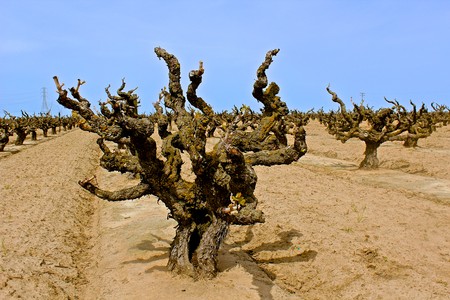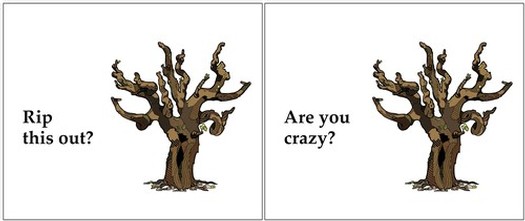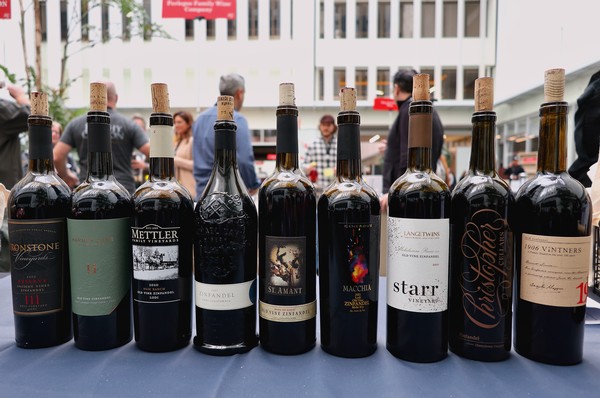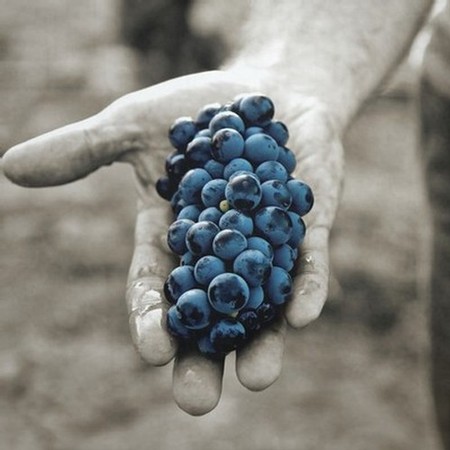Letters from Lodi
An insightful and objective look at viticulture and winemaking from the Lodi
Appellation and the growers and vintners behind these crafts. Told from the
perspective of multi-award winning wine journalist, Randy Caparoso.
Conversations with an English writer about the golden rule when telling the story of old vines

Lodi winemaker Mike McCay in Bonotto Vineyard—originally planted in the 1930s and, up until recently, producing Zinfandel that disappeared into anonymous vats of "jug" wines, but now recognized as a vineyard-designate varietal with distinctive qualities of its own.
Just minutes before a virtual webinar coming out of London and hosted by The Old Vine Conference this past March 25, 2024, a distinguished British journalist named Tamlyn Currin—also widely known as the Sustainability and Senior Editor for JancisRobinson.com—peppered me with questions in preparation for her on-air introduction to recipients of 2024 Old Vine Hero Awards.
Jancis Robinson herself is a Master of Wine (since 1984), and undoubtedly the most widely read wine author on the planet. Among her many achievements, she is the founder/editor of The Oxford Companion to Wine and co-author of Hugh Johnson's The World Atlas of Wine—two books considered to be the "holy bibles" by wine scholars all around the world.

Also significant to the California wine industry, Robinson is the original instigator of The Old Vine Registry, a hugely ambitious project that endeavors to list and provide information on every old vine vineyard in the world, which number in the thousands.
When The Old Vine Registry was officially launched in October 2023, Currin wrote the following about its inception, singling out Lodi as one particular region where old vine viticulture has been prioritized:
You may remember our Old Vines Register, which began life in 2010 as a simple spreadsheet to track old vineyards and the wines made from them, simply because the vines were undervalued and under threat. Jancis wrote in 2005, ‘These old vines are a wonderful resource. Take advantage before they are all grubbed up.’
Jancis wasn’t the only one. Viticulturist Rosa Kruger had begun compiling a list of old vineyards in South Africa more than two decades ago with the aim of protecting them, eventually leading to the foundation of the South African Old Vine Project in 2016. At the same time, organisations were springing up in California (Lodi specifically), Barossa and McLaren Vale in Australia and Maule in Chile, all with the purpose of raising awareness and preserving old vineyards. Sarah Abbott MW also had a vision for creating a credible, viable market category for wines made from old vines and, in February 2021, launched the Old Vine Conference. Energy and awareness of old-vine vineyards was gathering momentum.

A page from The Old Vine Registry on Bechthold Vineyard, Lodi's oldest continuously farmed vineyard, planted in 1886. Out of approximately 350 California vineyards chronicled in the Old Vine Registry, 53 of them are in Lodi.
As it were, during the webinar this past Monday Currin did not have the opportunity to explore all the topics we discussed ahead of time, but I think it is worthwhile going over her questions and my responses, relayed via email. Our conversation touched upon the challenge of communicating the importance and benefits of old vines around the world; particularly in California, where acreage of old vines is steadily shrinking (as opposed to growing, as we'd like it to be) as we speak.

Distinguished British wine journalist Tamlyn Currin.
Our exchange:
Currin: Randy, can you tell us how you became obsessed with old vines, and then, in particular, the old vines of Lodi?
Caparoso: When I first visited Lodi 22 years ago [in 2002] I was struck by its Mediterranean climate and deep sandy soils, which reminded me of vineyards I'd seen in South-West France, a perfect environment for long-lived, healthy grapevines, especially Mediterranean varieties. I was not surprised to immediately learn that there are far more acres of old vines (in California, defined as vineyards planted between the 1800s and 1960s) in Lodi than anywhere else in the country. In 2010, I moved into a cottage in the middle of a 60-year-old vineyard of Zinfandel, growing on its own roots, and have been "stuck in Lodi" ever since.

Soucie Vineyard Zinfandel, first planted on their own roots in Lodi's ultra-sandy soil in 1916, now producing one of the appellation's most distinctive vineyard-designate wines.
Currin: What are the different powers and impacts of the many different media you use: paper (books, magazine), digital writing (blogs, online columns), audio (face-to-face speaking, podcasts) and visual (photography)?
Caparoso: It is necessary to keep speaking about old vine viticulture in public forums precisely because old vine wines still have a minority appeal among consumers; although slowly but surely, interest in the topic of "old vines" has been growing. Photography, in fact, is another key to journalism focused on old vines, which is mostly digital these days, although I have published a successful book [re Lodi!] touching on the subject.
The crux of old vine plantings is that they have history. Wine lovers are naturally captivated by their stories as well as endless images of old vines, which seem to have the wisdom of age etched into their large, twisting trunks and spurs. It is the very robust physiology of old vines, which has a strong visual appeal, that gives them advantage in terms of long term grapevine health and enhanced ability to produce wines with stronger than average terroir expression. Generally speaking, the older the vine, the stronger their "sense of place" on a sensory level, which turns on wine lovers.

Graphics used in Lodi Winegrape Commission's ongoing Save the Old Campaign.
Currin: Do you have a favourite medium? Is one easier to use than another? Is one more rewarding than another?
Caparoso: Books and print magazines are still important, but no question we are more easily able to reach more consumers, as well as more trade and media, through online articles, relayed through social media. Make no mistake, we are in a losing battle right now insofar as communicating the reasons why old vine wines should be appreciated, and old vine plantings better appreciated. We are losing thousands of acres as we speak. Therefore, any kind of medium that reaches wine lovers and the rest of the wine industry is a "best way" to celebrate old vines.
Currin: Should we be weaving these platforms into each other?
Caparoso: Absolutely! I do traditional journalism and photography distributed primarily through online sites and blogs, but videos are another key to getting out the message. The people I work for, the grape growers belonging to the Lodi Winegrape Commission, have also been creating high production value videos telling the stories of old vineyards and the families who have been caring for them. In Lodi, families who have been doing this, for the most part, over 100 years. We are still losing more and more old vine blocks as we speak, but the more we can increase appreciation of them, the better.

At the Zinfandel Advocates & Producers Grand Tasting in San Francisco this past January, a line-up of premium level Lodi Zinfandels sourced from old vine plantings, most of them carrying vineyard-designations on the label.
Currin: What, for you, is the "golden rule" or "‘basic tenet" of communication–or rather, communication that drives change?
Caparoso: The "rule," if anything, is "tell the truth." Old vineyards and old vine wines speak for themselves. They do not need hype and should not require "high scores" to appeal to the consumers and industry. They go against the grain of how the wine industry largely operates today because they are real, they have historical significance, and represent the authenticity of terroir and appellations, which are still the base values of all the finest wines of the world. Old vines are an essence of why great wines have always had an enduring appeal.
Currin: What will it take, do you think, to set unstoppable change in motion?
Caparoso: Keep fighting, organize locally, organize nationally, and organize internationally. It's really hard for small regional groups to even get started on this because it takes the energy, time and dedication of a few inspired individuals and, in most cases, a big budget. You're also fighting against convention because most wines sold today follow commercial constructs and marketing plans which don't require placing value on older vineyards.

Zinfandel harvest in Harney Lane Winery's historic Lizzy James Vineyard, originally planted in 1904, producing wines that are distinctively "Lizzy" and bottled as such.
Not to be critical, but the media, while captivated by old vines, is also not as cooperative as they could be. They'd rather publicize top brands, high scoring wines, and glamorize vintners and lifestyles, not so much creaky old vineyards. As my old friend Kermit Lynch once put it, it's all about "pop"—popular styles, popular tastes, wines that go "pop" or "bang-bang" in the mouth. Wines expressing old vine terroir wind up being way down on the priority list of most media outlets.
In Lodi, we are continuously losing old vine plantings because of the steady drop in demand for those grapes for value priced wines such as White Zinfandel or $8 to $10 varietal reds and red wine blends. The older vineyards are just as susceptible to market trends as any other. The key to reversing that is to promote old vineyards as sources of premium priced wines, made by more handcraft vintners and appreciated for their sense of place—the specialness of each individual site.

Old vine Zinfandel cluster in Clements Hills-Lodi's Stampede Vineyard, planted between the 1920s and 1940s and now certified by California's Historic Vineyard Society as well as the UK's Old Vine Registry.
But that doesn't happen overnight, although it can happen because most old vine plantings are quite capable of producing distinctive wines. They wouldn't exist if they didn't. Meanwhile, though, the cost of farming old vines, which has to be done by hand, is steadily rising; something very much part of the current crisis.
In any case, the world owes resounding gratitude to The Old Vine Conference for taking the initiative of tackling the issue of vanishing old vine viticulture on an international scale. But it will also take every country, every region, maybe every sub-region or community to make a concerted effort to bring attention to their own treasure trove of old vine plantings.
Old vines are disappearing because, simply, they are not appreciated enough. Communication will be a key to breaking this pattern!

On a March 2024 day, a glass of Lodi Native Zinfandel in Marian's Vineyard, from which this wine was made, in as natural a style as possible in order to emphasize the distinct sensory qualities (i.e., "sense of place") of these vines and site.